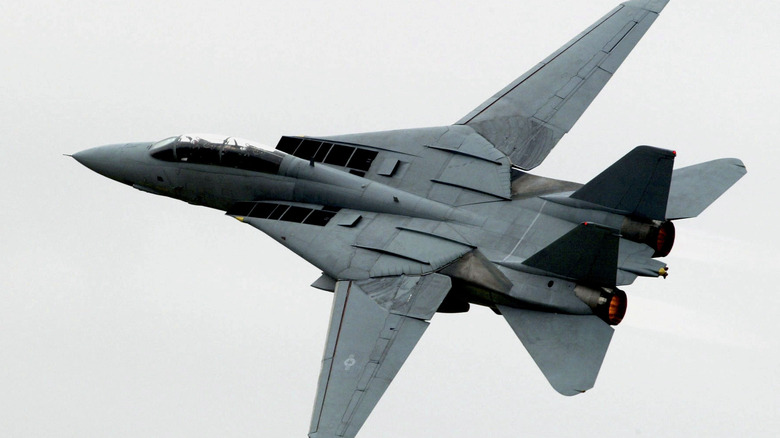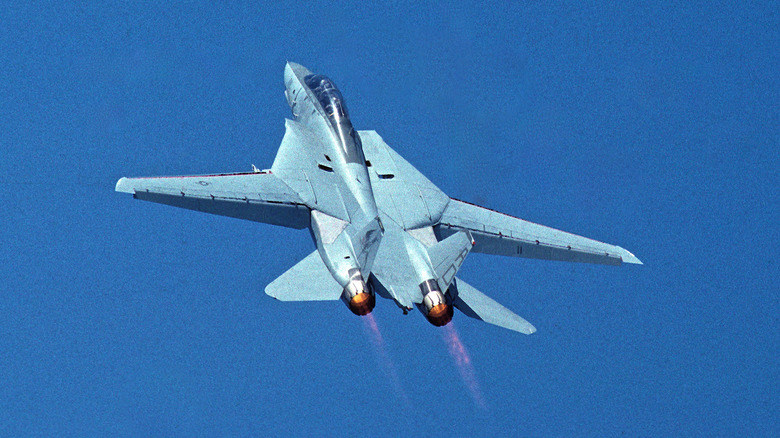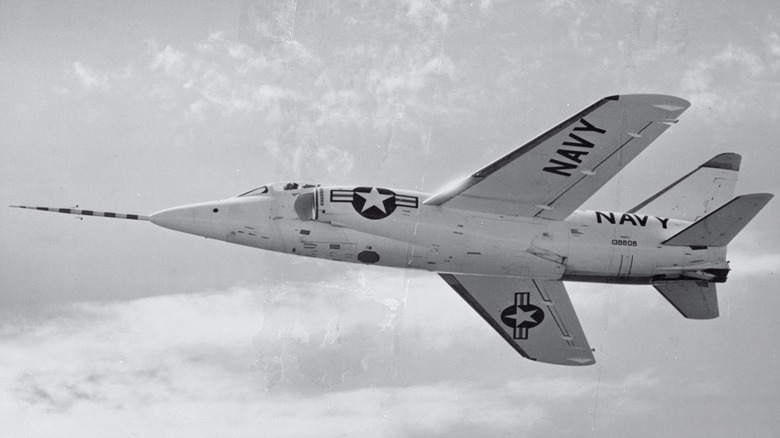How A U.S. Fighter Jet Shot Itself Out Of The Sky
When people started flying around in planes, it didn't take long for folks to throw weapons on board and fly them into combat. World War I saw the first widespread use of aircraft in war, but it wasn't until WWII that they developed into more efficient fighters and bombers. Once that happened, pilots and aviators balanced flying their planes and hitting their targets while avoiding incoming fire, making combat aircraft versatile and challenging to operate.
One thing that wasn't a concern initially was flying too fast to fire weapons, but that concern soon arose with the development of advanced jets. Before that, the only major concern with firing a weapon was ensuring pilots didn't hit their propellers while shooting their machine guns. However, the advent of jets capable of flying at supersonic speeds added a new concern. One such concern was realized via the Grumman F-14 Tomcat, which featured twin engines and the ability to hit speeds of 1,544 mph.
This made the Tomcat one of the deadliest strike aircraft in Navy history but added a new wrinkle to combat aviation. What happens when you fire a weapon system while flying at such high speeds? Will the aircraft travel faster than its missiles, and what dangers might this bring? These questions were answered on June 20, 1973, when an unexpected accident saw two pilots literally shoot themselves out of the sky.
Sometimes, even pilots shoot themselves down
Pilots Pete Purvis and Bill "Tank" Sherman flew an early model of the F-14 off the coast of Southern California during a test flight. The pilots conducted a test fire of the AIM-7 Sparrow missile, which was carried flush with the lower fuselage inside of the aircraft instead of from rails on the wings. After the pilot pulled the trigger, the missile's explosive bolts caused it to release in a freefall.
When the test occurred in 1973, things didn't work out as engineers planned. While traveling at 0.95 Mach (728 mph) and an altitude of 5,000 feet, the missile failed to exit the vehicle properly. Instead, it began to tumble through the air while releasing debris, which the F-14's engine intake immediately sucked inside. The engine burst into flames, the pilots ejected from the aircraft, and the F-14 crashed in the waters of the Pacific Ocean.
This test demonstrated why the Navy requires testing of its airborne weapons systems. What works on paper doesn't always work in practical applications, and while the F-14 tested the same missile system previously, this one incident shows why multiple tests are required. While the F-14's demise in 1973 proved a plane could shoot itself out of the sky with a missile, it wasn't an isolated incident.
Traveling faster than a speeding bullet isn't always wise
The first time a pilot accidentally downed their own aircraft came in September 1956. Thomas Attridge Jr. flew an F11F-1 Tiger at an altitude of 20,000 feet when he initiated a dive while firing his aircraft's 20mm rotary cannon. He engaged his afterburner, and at 7,000 feet, Attridge cleared his guns by pulling the trigger. After making contact with something mid-air, Attridge incorrectly believed he'd struck a bird when he actually hit his fired bullets.
The bullets impacted his aircraft, causing the engine to fail, resulting in a crash a couple of miles shy of the runway. Fortunately, Attridge survived the accident with a few broken bones, and it was determined the bullets hit the plane due to the drag they received while plummeting toward the ground. Once the aircraft reached a speed that exceeded the fired ordinance, it made contact, ensuring Attridge was the first pilot in history to shoot down his own jet aircraft.
That was the first of several incidents, one of which occurred in 2019 when a Dutch pilot operating an F-16 fighter jet did the same thing. While flying over the Netherlands, the pilot fired their 20mm rotary cannon and slammed into their own bullets, forcing them to make an emergency landing after taking significant damage to their aircraft. The full details of the incident aren't known, but the accident shows that more than 60 years after the first incident, pilots continue shooting themselves out of the sky.


